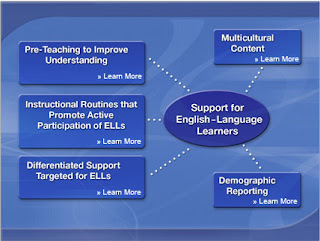As a teacher the probability of having all children who have had the privilege of going to preschool, first language being English and all from the same social rung is slim to none. But where others might see this difference as a downfall or hardship in teaching, others, myself included, are being taught to embrace these differences, explore upon them, and all children learn from them.
In my service learning school seventy percent of students are Hispanic and twenty five percent and considered “English as a Second Language” (from infoworks.com). I wonder how many students are unidentified as ESL, and what will happen if they are not identified to need the extra effort to master English. In my classroom alone I have knowledge of 3 students who have gone to ELL English Language Learners workshops, or at least they were notified about them. Within the classroom itself I do not see any attention to particle students, but I am unsure of attention outside of the time I was there.
As for addressing sociocultural differences, that is harder to pin point, many of the students in my classroom are from low class although they all bring some information with them into the classroom. Just last week I was help a boy Sharp with a book report on Rosa Parks and I asked what she was famous for he didn’t know, so I explained a little about how she refused to give up her seat on a public bus and how she sparked the civil rights movement, during this explaining Jim Crow laws at this point a girl Alysha turned around and asked me to explain more. When I told about separate schools and buses Sharp commented that it’s not like that in this city that everyone goes on the same bus ‘cause we’re nice. I thought this very cute and naïve but also sad, in the third grade I a largely segregated school these children had not grasped the large impact of the civil rights movement that continues in their classroom today. But that’s a little off topic.
Anyways back to the topic. One instance I do see mutual support in the classroom when the students are assigned to help one another. In math one day they were doing the chapter end activity and told to work in pairs, while helping one boy the two students sitting behind me were arguing liquid measurements, trying to find something they both know to figure out the problem. One of them said a big soda bottle was 2 liters and from there answered the problem, I took this example they had discovered and used it to help my student. So each student brings something to the table, for everyone to learn from.
Claude Goldenberg addressed the difficulties for students who first language is not English. Bringing to light how many students do not receive the attention they need, resulting in lower grade, disengagement in class, which overall leads to a lower quality of life, which could be addressed in school starting at the elementary level. He expects that a high number of students are not be identified as ELL or not receiving appropriate help; a very disheartening statement. He also gives ways that ELL students learn best, by learning concepts in their native language and applying it in English this along with integration to have their native language be available for questions or clarifications that the students may not be able to ask in English. Scaffolding, or starting from what students know and build upon that foundation on an individual level; would overall would given both students of linguistic and sociocultural differences a way to succeed to their potential.
Tuesday, May 4, 2010
Prompt 6 and Goldenberg
Posted by chuntfned at 3:52 PM 26 comments
Subscribe to:
Comments (Atom)
